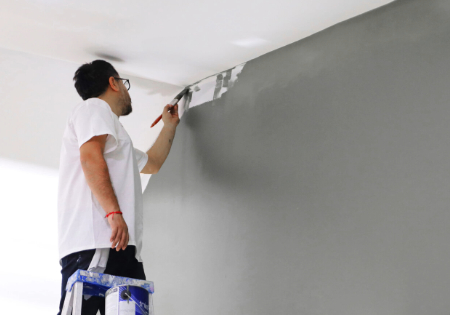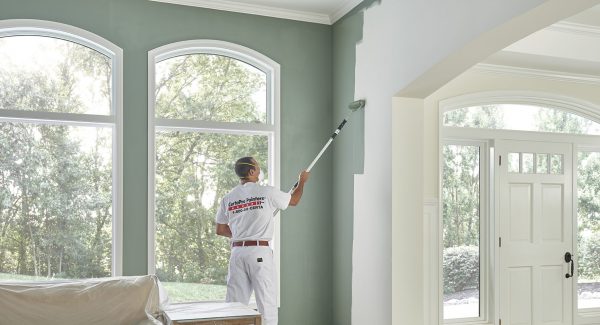Remain Ahead With New Paint Trends: Blending Techniques for Modern Interiors

The Rise of Color Gradients in Inside Design
As developers significantly look for innovative methods to boost spaces, the increase of shade gradients in indoor design has actually gathered significant interest. This technique, characterized by the smooth shift in between 2 or more shades, enables a vibrant visual impact that can change an average area right into a vivid setting. Shade slopes can stimulate emotions, affect perceptions of room, and develop focal factors, making them a versatile option for numerous design styles.
The application of gradients prolongs past wall surfaces; they can be effectively employed in furnishings, textiles, and accessories. Developers often try out varying tones to achieve depth and intrigue, interesting a range of appearances from minimalist to diverse. Furthermore, the adaptability of gradients enables their usage in both property and business settings, accommodating diverse clientele. As trends advance, making use of shade gradients symbolizes a shift towards more meaningful and personalized indoor rooms, mirroring individual preferences and way of lives.
Welcoming Ombre Techniques for a Dynamic Look
Ombre techniques have actually become an enchanting option for those seeking to add depth and movement to modern-day insides. This gradient impact shifts efficiently from one color to one more, producing an aesthetically striking focal point in any space. Developers appreciate ombre for its flexibility; it can be put on wall surfaces, furniture, or perhaps decorative accents, enabling special expressions of style.
The method works particularly well with soft tones, offering a calm atmosphere, while strong colors can energize a space. Property owners can trying out numerous shade palettes, picking different tones for a remarkable impact or harmonious tones for a refined result. The application of ombre is not limited to a solitary wall surface; it can expand throughout a space, improving the understanding of space and light.
As a contemporary trend, ombre methods satisfy diverse tastes, allowing individuals to individualize their interiors and accept creativity in their layout method. corpus christi tx paint shop.
Distinctive Wall Surfaces: Layering Paint for Depth and Rate of interest
Textured walls can considerably boost the visual charm of modern-day interiors by including deepness and rate of interest. Methods for producing texture, thoughtful color combinations, and the right devices for layering are crucial elements in accomplishing this result. Discovering these components allows for a vibrant and tailored strategy to interior decoration.
Techniques for Structure Creation
Producing visual interest in interior rooms commonly rests on the artful application of structure. Numerous techniques can be utilized to achieve this, such as sponging, cloth rolling, and stippling. Sponging includes using a wet sponge to use a second color over a skim coat, creating a soft, mottled effect. Dustcloth rolling, on the various other hand, utilizes a rolled cloth to use paint, leading to a more vibrant structure. Stippling employs a stiff brush or tool to swab paint onto the surface, developing a special pattern. Additionally, layering various surfaces, such as matte and shiny, can boost deepness. These techniques not only provide visual appeal yet additionally add to the total ambiance of contemporary interiors, motivating a responsive experience.
Shade Mixes for Effect
Layering paint not only enhances structure but likewise opens up a globe of shade combinations that can substantially influence the state of mind of an area. By blending complementary tones, designers can develop a harmonious impact that welcomes warmth or coolness, depending upon the wanted ambience. Rich planet tones coupled with soft pastels can stimulate a calm environment, while vibrant, contrasting shades can add vibrancy and power. Furthermore, integrating shiny or metal surfaces within the layers can introduce a vibrant aesthetic element, capturing light and enhancing the deepness of the color pattern. Ultimately, thoughtful shade mixes with layering paint provide a possibility to reveal specific style while changing ordinary walls right into captivating centerpieces.
Devices for Layering Impact
Different tools are important for achieving a successful layering result in paint applications, which can change wall surfaces into captivating aesthetic experiences. Rollers and brushes are basic, with varied dimensions permitting different textures and surfaces. Specialty devices like sponges and rags can create special patterns and deepness, while combination knives provide precision for even more specified lines. For larger locations, utilizing a stippling brush can add a detailed finish. Additionally, spray weapons can effectively use multiple layers for a smooth, even coat. Painters ought to additionally think about painter's tape to produce tidy edges in between layers. By making use of the right devices, one can effectively enhance the aesthetic appeal of insides, making each wall an appealing prime focus.

The Power of Shade Obstructing in Modern Spaces
As contemporary interior decoration remains to evolve, color obstructing becomes a powerful technique that can change areas with bold visual influence. This approach includes the calculated positioning of contrasting shades to develop defined zones within a space, boosting both the visual charm and performance of the area. corpus christi paint store. By using huge swathes of shade, developers can assist the eye and highlight architectural aspects, resulting in a dynamic atmosphere
Shade stopping is not limited to walls; it can also be applied to furnishings and decor, permitting for countless personalization. Combining a vivid color with a neutral tone can develop a striking focal point while maintaining equilibrium. This strategy encourages imagination, allowing home owners to share their individualities with unique color mixes. Ultimately, color blocking acts as an effective method to revive modern-day interiors, making spaces really feel fresh, energetic, and aesthetically interesting.
Incorporating Metallics for an Extravagant Complete
Just how can metallics elevate the elegance of modern-day insides? Metal surfaces work as a striking prime focus, including depth and aesthetic interest to spaces. They can transform a conventional area into a classy resort through the refined interaction of light and reflection. Developers typically advise integrating metallics in accent wall surfaces, ceilings, or furnishings to produce a glamorous ambience without overwhelming the area.
Numerous metallic tones-- such as gold, bronze, and silver-- offer versatility, permitting property owners to customize their visual. For example, a soft gold can present heat, while a streamlined silver can lend a modern touch. When matched with neutral tones, metallics boost the overall design, offering an advanced contrast that attracts the eye.
Including metallic paint into trim or moldings can additionally raise architectural information, creating a refined finish. Ultimately, the critical use metallics can infuse contemporary insides with prestige and refinement, making them genuinely captivating.
Creative Use of Stencils for Special Patterns
Transforming wall surfaces with stencils can instill contemporary interiors with distinct character and design. This imaginative method enables designers and house owners to develop customized patterns that mirror individual aesthetic appeals. Stencils can range from complex geometric designs to whimsical concepts, making it possible for a large range of expressions. By picking different shades, stencils can elevate a room's visual charm and act as focal points without overwhelming the room.
Furthermore, stencils are versatile; they can be put on numerous surfaces, including wall surfaces, furnishings, and also ceilings. This flexibility makes stenciling an ideal selection for do it yourself enthusiasts wanting to improve their space economically. Furthermore, the convenience of application and elimination permits trial and error, making it possible for people to freshen their style with minimal initiative. Eventually, innovative usage of patterns not just changes ordinary surface areas however also provides a chance for self-expression, making them a trending choice in modern-day interior style.
Mixing Matte and Shiny Surfaces for Comparison
The interplay of matte and glossy surfaces can develop a striking visual dynamic in contemporary insides. Designers often utilize this contrast to improve building functions and specify rooms. Matte finishes, with their soft, non-reflective top quality, can create a sense of heat and affection, making them optimal for wall surfaces and larger surface areas. On the other hand, shiny coatings mirror light, including vibrancy and deepness, making them appropriate for accents such as trim, moldings, or furnishings.
The mix of these textures can assist the eye and emphasize centerpieces within an area. Pairing a matte-painted wall with shiny cabinetry can create an innovative balance. Additionally, the mindful application of both finishes can evoke different state of minds while boosting the total aesthetic. As home owners progressively look for personalized areas, mixing matte and shiny finishes provides a versatile approach to attaining contemporary beauty and aesthetic rate of interest in interior decoration.
Regularly Asked Inquiries
What Equipment Are Best for Mixing Paint Strategies?
A range of tools are perfect for mixing paint techniques, consisting of foam rollers, brushes with soft bristles, sponge applicators, and airbrushes. Each tool supplies unique impacts, enhancing the blending procedure for numerous imaginative applications.
How Can I Fix Mixing Mistakes?
To fix mixing errors, one ought to lightly sand the affected area, use a primer if essential, and afterwards thoroughly reapply paint utilizing a soft brush or sponge to attain a smooth change and recover the wanted result.
Exist Specific Paint Brands Recommended for Blending?
Several paint brands are recommended for blending, consisting of Benjamin Moore, Sherwin-Williams, and Behr. These brand names use top notch coatings and a large variety of shades that help with smooth shifts and effective blending techniques in different interior projects.
Can I Mix Paint Without Professional Assistance?
Yes, mixing paint without professional aid is feasible. With technique and the right tools, individuals can attain desirable effects. Various online tutorials and overviews can assist in mastering blending methods for personal jobs.

The Length Of Time Does Blended Paint Last on Wall Surfaces?
Blended paint can last anywhere from 5 to 10 years on wall surfaces, depending upon aspects such as the quality of paint used, surface prep work, and environmental conditions. Routine maintenance commonly boosts longevity and look.
As designers progressively look for ingenious means to improve spaces, the rise of shade gradients in interior layout has actually gathered substantial attention. The technique works specifically well with soft colors, giving a peaceful ambiance, while vibrant shades can energize an area. Strategies for developing texture, thoughtful color mixes, and the right tools for layering are necessary parts in attaining this impact. Layering paint not only enhances structure yet additionally opens up a world of shade mixes that can considerably affect the state of mind of a space. As contemporary interior design continues to advance, color obstructing emerges as a powerful method that website can change rooms with bold visual impact.